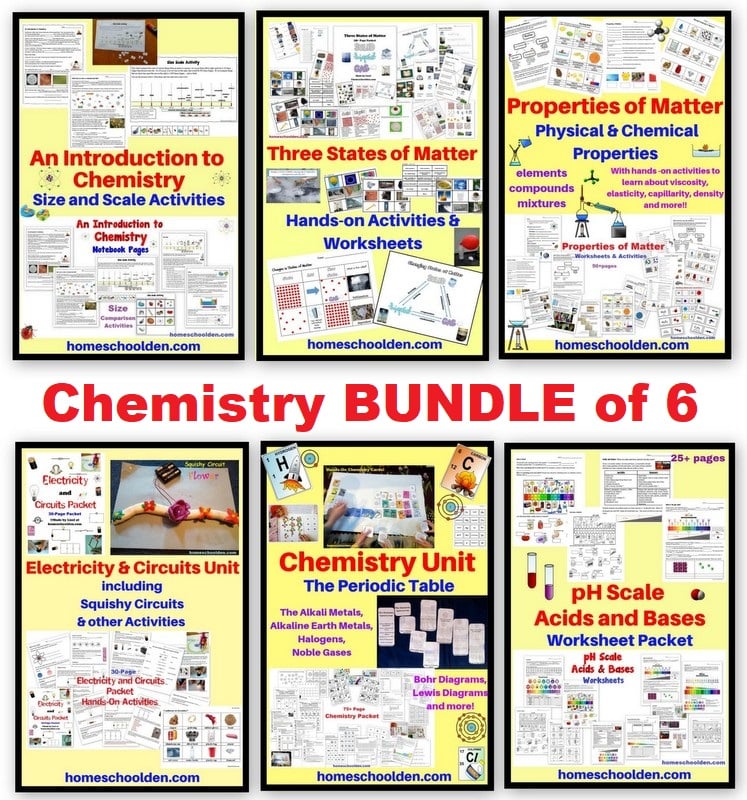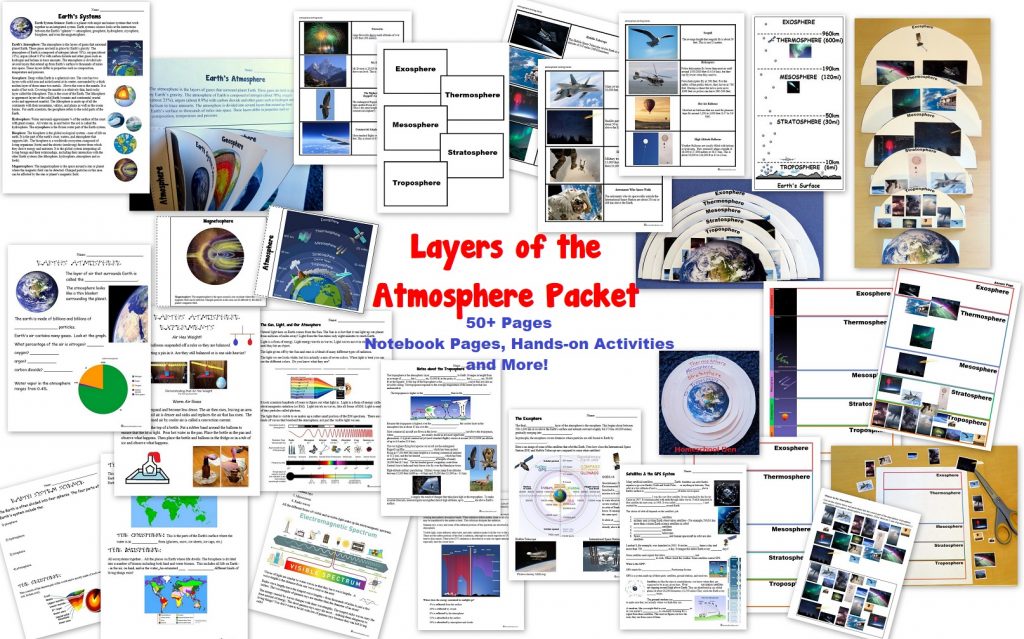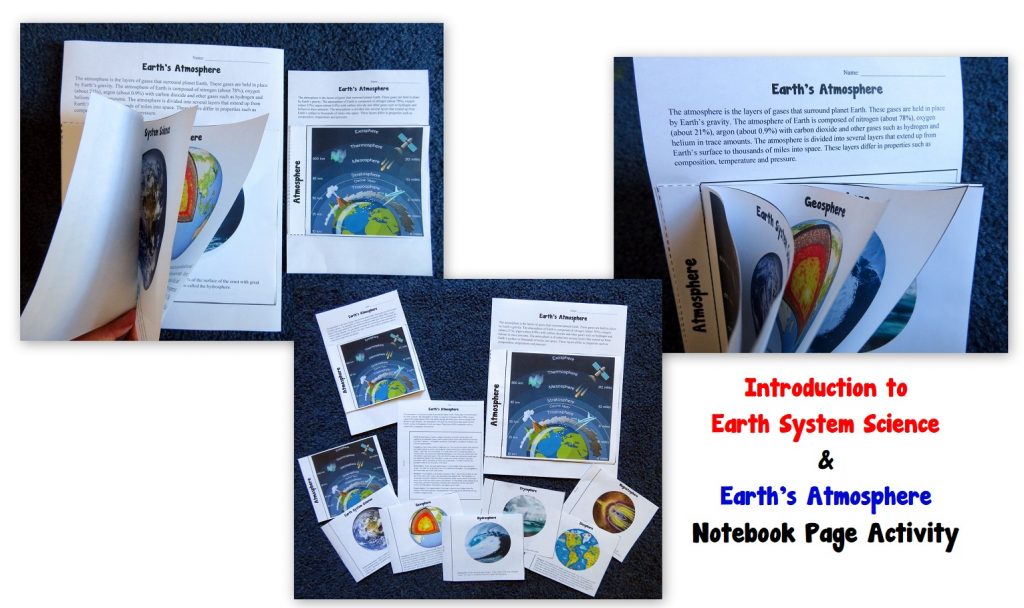States of Matter: Hands-On Activities about Gases
We started our chemistry unit this year with a study of the States of Matter – Solids, Liquids and Gases. Today, I’m going to share four hands-on activities we did about air.
We started the unit with a discussion of the states of matter: solids, liquids and gases.
The kids had to brainstorm as many examples as they could in two minutes. Then they shared their examples. I then asked them to count how many they had listed – and challenged them to beat their previous number! I set the timer again for two minutes and they wrote furiously!! We used the printable from our States of Matter packet for this activity. Then they filled out the notebook page with pictures of various solids, liquids and gases.
Several years ago, the kids made interactive-notebook pages about the 3 States of Matter



I asked the kids if air has weight or if air takes up space. They weren’t sure, so we did a couple of activities that gas, indeed, has weight and takes up space.
Hands-On Activity: Air has weight.
Take a ziploc bag. Seal it most of the way with a straw on one end. Place a couple of books on the bag. Have your student force air into the bag through the straw demonstrating that air takes up space!

In this activity, we talked about the composition of our air. I asked the kids what gases they thought made up most of our air, they tossed out oxygen, carbon-dioxide and hydrogen. Then we talked about the actual composition of air which surprised them!
I went over how to make a bar graph and a pie graph (using markers as an example)
So, that’s about it for today. Next time I will share some of the activities we did as we learned about some of the characteristics of liquids (adhesion, cohesion, surface tension, etc.)
Check out our 50+ Page Three States of Matter Packet
After finishing this unit, we went straight on to our next unit, the Physical and Chemical Properties of Matter.
In the Properties of Matter Unit we are studied:
- Matter: Elements, Compounds, Mixtures
- Organization of the Periodic Table
- Molecular vs. Structural Formulas
- Describing Matter: Physical and Chemical Properties
- Density Activities – Mass÷Volume
- Mixtures: Solutions, Colloids and Suspensions
Chemistry BUNDLE purchase these 6 units together
- Introduction to Chemistry – Size of Atoms Mini-Unit
- States of Matter Packet
- Properties of Matter Packet
- Electricity & Circuits Packet
- Chemistry Packet
- pH Scale – Acids and Bases Worksheet Packet
Chemistry BUNDLE of 6
$27.99


$2.99 Introduction to Chemistry – Size of Atoms Mini-Unit
$5.99 States of Matter Packet (50+pages)
$7.99 Properties of Matter Packet (now close to 100 pages)
$6.99 Electricity & Circuits Packet (30+pages)
$8.99 Chemistry Packet – An introduction to the Periodic Table (150 pages) – Learn how the periodic table is organized and find out more about the different groups of the periodic table (Alkali metals, alkaline earth metals, halogens). Learn what valence electrons are and do some fun activities to create Lewis structures. Learn about the first twenty elements as well as elements with unusual names. Plus, learn about electron configuration and more! (We did this primarily in middle school, but did electron configuration in high school again.)
$2.99 pH Scale – Acids and Bases Worksheet Packet (25 pages) – Includes material for younger students (elementary/middle school) and older (high school) students.
$7.99 Ions and Isotopes Chemistry Unit (125 pages) This unit is an introduction to ions (which have fewer or more electrons) and isotopes (which have fewer or more isotopes). This unit should be done after students have completed the Chemistry Unit. (middle school/high school)
$9.99 Organic Chemistry Unit (100+ pages) Organic chemistry is the chemistry of carbon-containing molecules. In this unit, we study many of the organic compounds that include carbon and hydrogen (hydrocarbons), carbon-carbon molecules and more! This unit covers hydrocarbons, functional side groups and the four classes of macromolecules: carbohydrates, proteins, fats and nucleic acids. *high school level unit
Click on the link to see more details about each of these units:
Introduction to Chemistry – Size of Atoms Mini-Unit
Chemistry Packet: The Periodic Table
As you know, we love hands-on activities and I want to show you some of the fun ways we explored the periodic table and touched on topics like valence electrons, Bohr Diagrams, Lewis Diagrams (electron dot diagrams), ions, isotopes, and more!
Some of the topics we explored included:
- Building the Periodic Table
- Bohr Diagrams & Understanding Valence Electrons
- Periods, Groups & Families
- hydrogen & the alkali metals, alkaline Earth metals, halogens, noble gases
- Atomic Number, Atomic Mass & Chemical Symbols
- Lewis Diagrams
- Metals, Metalloids and Nonmetals
- Unusual Element Symbols
- Trends of the Periodic Table
- Electron Configuration
We did this unit together when the kids were 10, 12 and 14. I think this unit is best for middle school and up (perhaps as a supplement to for high schoolers being introduced to chemistry for the first time).
Click here to see more details about our Chemistry Packet:
You might also want to check out our Layers of the Atmosphere Packet




Disclosure: Please note that some of the links in this post are affiliate links, and at no additional cost to you, I will earn a commission if you decide to make a purchase.
Other chemistry posts that may be of interest:
- Chemistry Experiments for Kids (Grade 2) – Matter is Neither Created Nor Destroyed — Acids and Bases
Don’t miss our FREE chemistry packet from last year:
- Chemistry Experiments for Kids (Grade 2) – Mixtures, Chromatography, DNA Kit
- Chemistry Unit: Periodic Table – The chemistry unit we did last year as we learned about the main groups of the periodic table
- Alkali Metals — reactive
- Alkaline Earth Metals
- Halogens
- Noble Gases
- Chemistry Unit: Bohr Diagrams (this post has a free printable)
- Explosion of Colors in Milk Experiment and Other Chemistry Fun!
- Chemistry Unit: The Size of Atoms
- States of Matter: Solid, Liquid, Gas — Learning Activities
- Chemistry: Molecule Movement Experiment and Chemistry Review Worksheet These notebook pages are free.
- Science Experiments: Water Molecule Attraction
- Building Molecules Chemistry Activity This also has some free notebook pages about building molecules:


See you again soon here or over at our Homeschool Den Facebook Page! Don’t forget to Subscribe to our Homeschool Den Newsletter. You might also want to check out some of our resources pages above (such as our Science, Language Arts, or History Units Resource Pages) which have links to dozens of posts. You might want to join our free Homeschool Den Chat Facebook group. Don’t forget to check out Our Store as well.

~Liesl
Disclosure: Please note that some of the links in this post are affiliate links, and at no additional cost to you, I will earn a commission if you decide to make a purchase.







































































